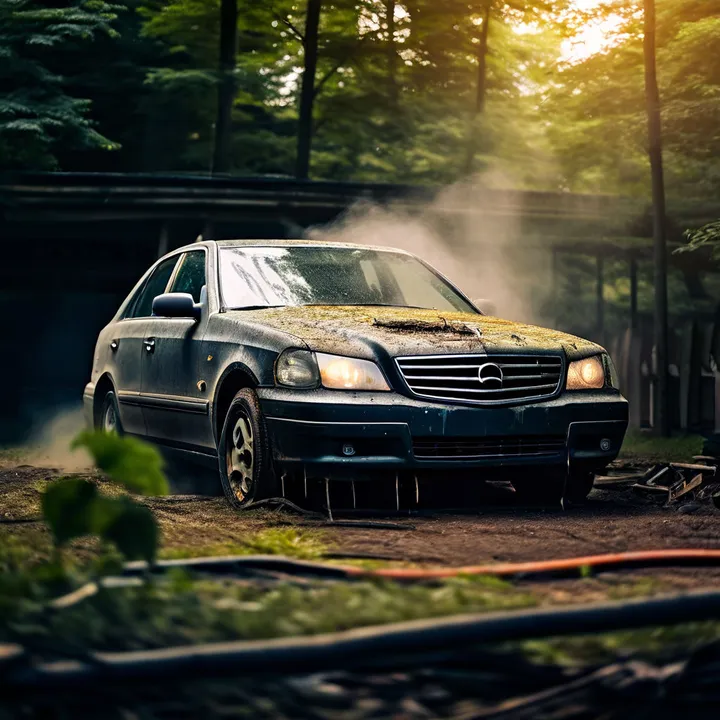


The air conditioning condenser is an essential component of the system, responsible for releasing the heat absorbed from the indoor air. It is typically located outside the building and consists of a coil and a fan. Over time, the condenser can become clogged or dirty, restricting airflow and hindering the system's ability to function efficiently. This issue can lead to various problems, including reduced cooling capacity, increased energy consumption, and potential system failure if left unaddressed.
In this comprehensive guide, I'll share my expertise and walk you through the causes, identification methods, repair procedures, and preventive measures for addressing a clogged or dirty condenser coil. Whether you're a DIY enthusiast or simply seeking a better understanding of your vehicle's air conditioning system, this article will provide you with valuable insights and practical tips.

One of the primary reasons for a clogged or dirty condenser coil is the accumulation of various contaminants over time. The outdoor location of the condenser unit exposes it to a range of environmental factors, as shown in the table below:
| Environmental Factor | Description |
|---|---|
| Dirt | Airborne particles can settle on the coil fins |
| Dust | Fine particles from various sources can accumulate |
| Leaves | Falling leaves can get trapped in the coil |
| Grass Clippings | Debris from lawn mowing can clog the coil |
| Other Debris | Twigs, insects, and other outdoor elements |
These particles can gradually build up on the coil fins, acting as insulation and hindering proper heat transfer and airflow. If left unchecked, this buildup can have severe consequences, such as:
Reduced cooling efficiency
Higher energy consumption
Potential system failure
As an automotive expert, I've witnessed firsthand the detrimental effects of a neglected condenser coil, and I cannot stress enough the importance of addressing this issue promptly.
Before attempting any repairs, it's crucial to properly identify the problem. Here are the steps I typically follow when inspecting a suspected clogged or dirty condenser coil:
Turn off the AC unit and disconnect power
Remove the outer casing of the outdoor unit
Visually inspect the coil for any buildup of dirt, debris, or bent fins
Use a soft brush or vacuum to gently remove any loose debris
During this inspection process, there are several telltale signs that can indicate a clogged or dirty condenser coil:
| Sign | Description |
|---|---|
| Reduced cooling performance or warm air from vents | One of the first noticeable symptoms |
| Higher than normal energy consumption | The system has to work harder |
| Frost or ice buildup on the coil | Caused by restricted airflow |
| Strange noises or vibrations from the outdoor unit | Debris or bent fins can cause unusual sounds |
| Visible dirt, leaves, or other debris clogging the coil fins | The most obvious sign |
If you notice any of these signs, it's time to take action and address the issue before it escalates.
Once you've identified the problem, the next step is to properly clean or repair the condenser coil. Here's the process I typically follow:
Carefully remove any remaining debris using a soft brush or coil cleaning tool
Clean the coil with a suitable solution:
Coil cleaning solution (follow manufacturer's instructions)
Mixture of water and mild detergent
Rinse the coil with clean water to remove any residual cleaning solution or debris
Straighten bent fins using a fin comb
Replace the coil if it is severely damaged or corroded (may require professional assistance)
Throughout the cleaning and repair process, it's crucial to exercise caution and follow proper safety protocols. Avoid using high-pressure water or compressed air, as these can further bend or damage the delicate coil fins. Additionally, be gentle when cleaning to prevent inadvertently causing more harm than good.
Once the coil is thoroughly cleaned and any necessary repairs are made, ensure it is completely dry before reassembling the outdoor unit. If the coil is heavily clogged or damaged, it may be advisable to seek professional cleaning or replacement services to ensure the job is done correctly and efficiently.
While cleaning and repairing a clogged or dirty condenser coil is essential, prevention is equally important to maintain the longevity and optimal performance of your vehicle's air conditioning system. Here are some tips and best practices I recommend:

Regular maintenance
Schedule regular cleaning and maintenance for your condenser coil
At least once a year, or more frequently in dusty or debris-prone areas
Proactive approach can prevent excessive buildup and catch potential issues early
Replace air filters regularly
Clogged air filters can contribute to debris reaching the condenser coil
Follow manufacturer's recommendations or replace as needed
Keep the area around the outdoor unit clear
Remove any vegetation, leaves, or other debris that could obstruct airflow or accumulate on the coil
Ensure proper airflow
Make sure the outdoor unit has adequate clearance and is not obstructed by objects
Follow manufacturer's guidelines for recommended clearance distances
Schedule professional inspections
In addition to regular maintenance, consider scheduling professional inspections and servicing
Trained technicians can identify potential issues and perform thorough cleanings or repairs
By following these preventive measures, you can significantly reduce the likelihood of a clogged or dirty condenser coil and extend the lifespan of your vehicle's air conditioning system.
When it comes to addressing a clogged or dirty condenser coil, the cost can vary depending on the extent of the issue and whether professional assistance is required. Here are some general cost estimates to consider:
| Service | Cost Range |
|---|---|
| DIY cleaning | $10 - $50 for cleaning supplies and tools |
| Professional cleaning | $100 - $300, depending on unit size and level of cleaning required |
| Coil replacement | $400 - $1,000 or more, including labor and materials |
It's important to note that neglecting a clogged or dirty condenser coil can lead to higher energy costs, reduced efficiency, and potentially costly repairs or premature system failure in the long run. Investing in regular maintenance and addressing issues promptly can save you money and extend the lifespan of your air conditioning system.
As an automotive mechanical expert, I cannot overstate the importance of maintaining a clean and unobstructed condenser coil in your vehicle's air conditioning system. By understanding the causes, identifying the signs, and following proper cleaning and repair procedures, you can ensure optimal performance and efficiency.
Remember, prevention is key. Implementing regular maintenance routines, keeping the area around the outdoor unit clear, and scheduling professional inspections can go a long way in avoiding costly repairs and premature system failure.
If you encounter any issues or have concerns about your vehicle's air conditioning system, don't hesitate to seek professional assistance. A trained mechanic can provide expert guidance and ensure the job is done correctly, safeguarding the longevity of your vehicle's components.
Stay cool, drive safe, and keep those condenser coils clean!
Neglecting to clean your AC coils can lead to reduced cooling efficiency and higher energy bills. It can also cause premature system failure and costly repairs.
It's recommended to clean your AC coils at least once a year, or more frequently if you live in a dusty or debris-prone area.
No, using a pressure washer can damage the delicate fins on the coils. It's best to use a garden hose with low pressure or a specialized coil cleaning solution.
You'll need a soft-bristled brush, a garden hose, a coil cleaning solution (or a mixture of water and mild detergent), and possibly a fin comb to straighten bent fins.
While the cleaning process is similar, you should be more cautious when cleaning indoor coils to avoid getting water or cleaning solutions inside the ductwork or electrical components.
Always turn off the power to the AC unit and wear protective gloves and eyewear when handling cleaning solutions.
Yes, dirty coils can harbor mold, bacteria, and other contaminants that can circulate through your home's air, potentially causing respiratory issues or other health problems.
Regular maintenance, changing air filters, and keeping the area around the outdoor unit clear of debris can help prevent excessive buildup on the coils.
Yes, commercial coil cleaners specifically designed for air conditioning units are safe and effective for cleaning coils. Always follow the manufacturer's instructions.
If you're not comfortable or able to clean the coils yourself, it's best to hire a professional HVAC technician to ensure the job is done correctly and safely.

Sarah isn't your average gearhead. With a double major in Mechanical Engineering and Automotive Technology, she dived straight into the world of car repair. After 15 years of turning wrenches at dealerships and independent shops, Sarah joined MICDOT to share her expertise and passion for making cars run like new. Her in-depth knowledge and knack for explaining complex issues in simple terms make her a valuable asset to our team.





